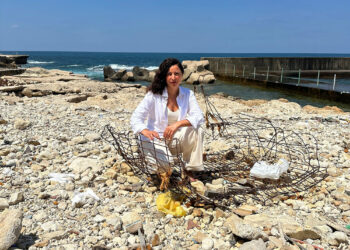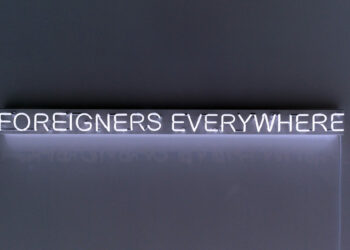Juan Stockenstroom is no Jean-Michel Basquiat wannabe, though the comparison is unavoidable. The difference, however, lies in the way in which Stockenstroom occupies space. Basquiat arrives at the butt-end of Abstract Expressionism, in the slipstream of Pop, in which negative space is crucial. His canvasses need oxygen. Signage, or faces used as signage, float in fields of colour. Stockenstroom, on the other hand, crams his canvasses full, because he wants to “talk you out of the room”. Having worked in advertising, most recently as a creative director for a small design firm, he “understands what holds attention”. He “fills up everything”, he says, his entry point being colour saturation.
 Juan Stockenstroom, A Stairway to heaven, 2020. Acrylic and oil ink on canvas, 110 x 84cm. All images courtesy of the artist & Berman Contemporary.
Juan Stockenstroom, A Stairway to heaven, 2020. Acrylic and oil ink on canvas, 110 x 84cm. All images courtesy of the artist & Berman Contemporary.
Stockenstroom’s iconography is not as terse, nor as obscure, like Basquiat’s. It is not mystery, or mystique, that energises him, but a face-off. We are caught in a deadlock. If he talks you out of the room, it’s because what interests him most is the density of African life and experience. Both his studio and home are but a short walk away from the Wynberg taxi rank in Cape Town, which reminds him of a Lagos market. Wynberg’s business district, with its informal businesses spilling onto the street, conveys the same congestion. These arenas are his core inspirations. He loves observing people, “life happening, people on the move, people bargaining, drug deals going down, people trying to rob other people”.
It is this coalface – Afropolitanism in action – which finds its way onto canvasses thickly infused with life’s infinite variations. A jazz score, Stockenstroom’s paintings possess a dissonant overdrive. One hurtles from place to place, the eye caught in a feeding frenzy. Even if inspired by Basquiat, Stockenstroom is stimulated far more by the hubbub of African life, its market places, street deals, excessive pooling of energies impossible to aggregate – hence the visual dissonance – yet the artist’s uncanny capacity to gel that morphing, churning disorder together is evident.
Starting out as a photographic re-toucher – ensuring the image is “glossy and perfect” – Stockenstroom decided to break away. Painting in the way he does proved liberating. Perfection gave way to imperfection, gloss to a glow which, while bright, seems to wheeze and snort, blast and flicker. Painting, he says, is “anti”. It allowed for “a great sense of freedom”. He first posted his paintings on Instagram, the gateway drug for imagery. A growing interest resulted, but Stockenstroom, who is self-taught, was looking for more solid backing – a gallery that could show his work. Since 2019, Juan Stockenstroom is represented by Berman Contemporary in Johannesburg.
 Dance of the Sugar Rum Fairy, 2020. Acrylic and oil ink on canvas, 100 x 75cm.
Dance of the Sugar Rum Fairy, 2020. Acrylic and oil ink on canvas, 100 x 75cm.
Stockenstroom is drawn to Pop Art’s faux glitter: “As a kid, my drawing was influenced by post-apartheid cartoons. A hand would look like a bunch of doughnuts.” It is this anti-realism – which, for Stockenstroom, is just another way of looking and making –that is garnering rapid interest. That he has been able to achieve this support in less than two years is remarkable. That his ratcheting success has come without an art school qualification – “which is like getting a British passport”, easy access to the art world – is all the more remarkable. He is a “seeker”, he says, “not a follower of dogma”.
Click here to view the exhibition.
Ashraf Jamal is a writer, editor and teacher. His recent publications are Robin Rhode: The Geometry of Colour, and In the World: Essays on Contemporary South African Art. Both books are published by SKIRA.



